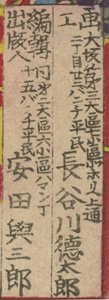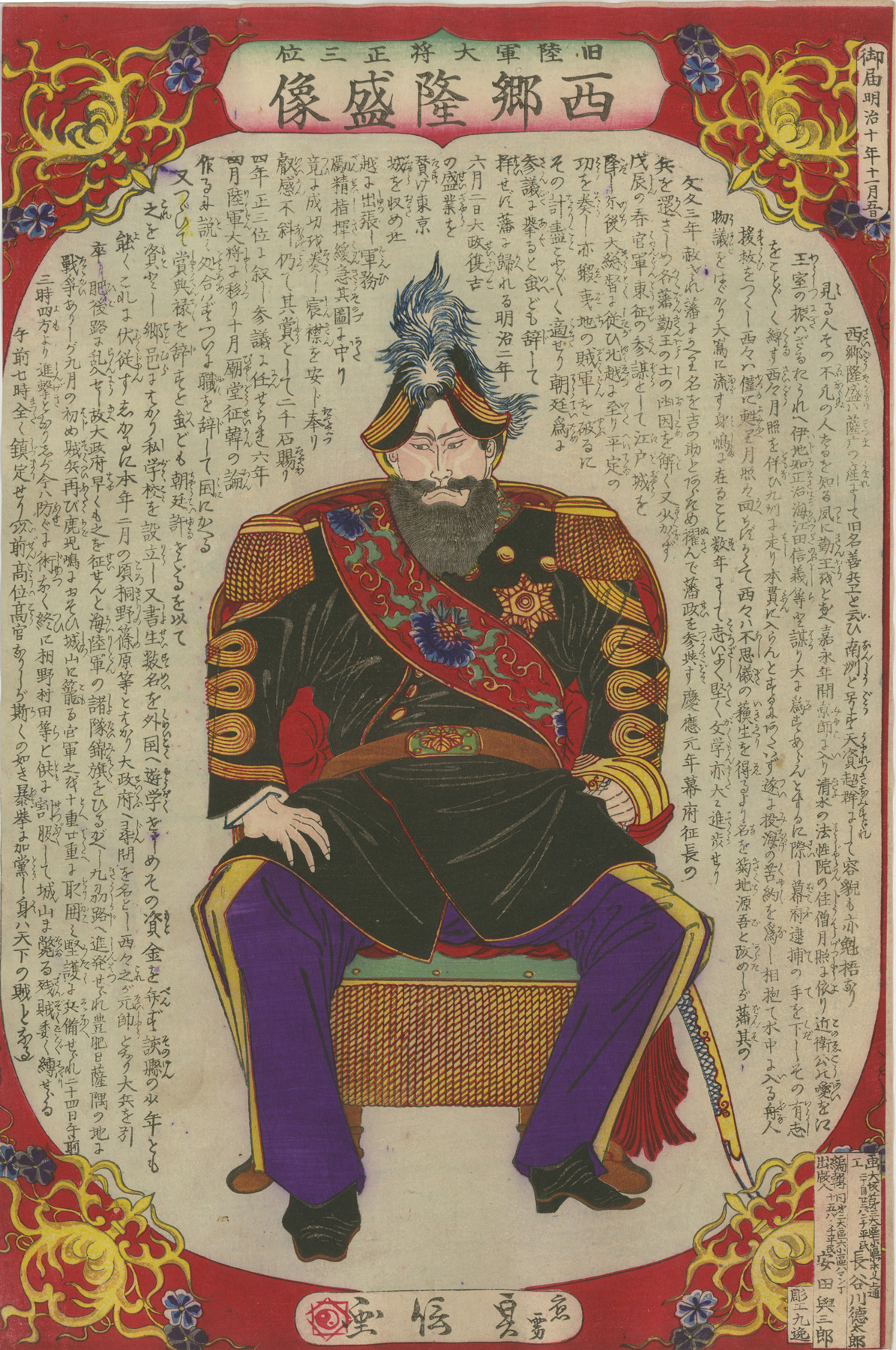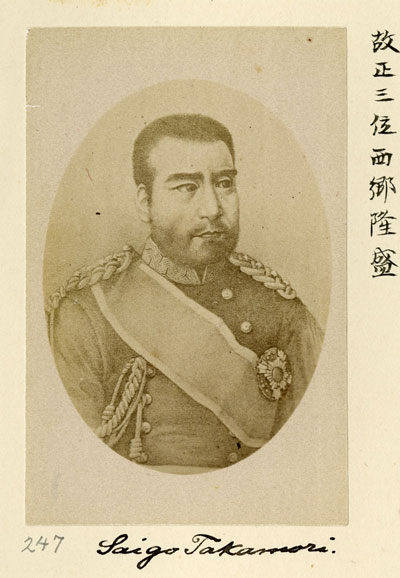About This Print
Issued in the beginning of November 1877, approximately six weeks after the end of the nine month Satsuma Rebellion (see the article Satsuma Rebellion and Saigō Takamori Prints) and the death of its leader, Saigō Takamori, this print portrays Saigō decked out in all his military finery from the days when he was one of the most powerful men in the new Meiji government. While it was not until the end of February 1889 that Saigō, the rebel, received his official state pardon and the restoration of his imperial court rank, he and his top commanders were portrayed as heroes by print makers and their publishers as soon as the rebellion was crushed.This installation features more than 30 loans from two remarkably rich local resources, the Lavenberg Collection of Japanese Prints, and the Lee & Mary Jean Michels Collection. It was co-curated by Professors Akiko Walley (History of Art and Architecture) and Glynne Walley (East Asian Languages and Literatures) and JSMA Chief Curator Anne Rose Kitagawa. QR codes on selected labels allow visitors to access translations and explanations of the complex wordplay, imagery, and cultural context of these fascinating objects.
HASEGAWASadanobu II/Konobu I
(二代長谷川貞信/初代小信, 1848-1940)
Japanese;Meiji period, November 5, 1877
Portrait of Saigō Takamori, Former Army GeneralSenior Grade of the Third Court Rank (KyuRikugun Taishō Shōsanmi Saigō Takamori zō)
Ukiyo-e woodblock print in vertical ōban format; ink and color on paper
The LavenbergCollection of Japanese Prints, IHL.1171
This installation features more than 30 loans from two remarkably rich local resources, the Lavenberg Collection of Japanese Prints, and the Lee & Mary Jean Michels Collection. It was co-curated by Professors Akiko Walley (History of Art and Architecture) and Glynne Walley (East Asian Languages and Literatures) and JSMA Chief Curator Anne Rose Kitagawa. QR codes on selected labels allow visitors to access translations and explanations of the complex wordplay, imagery, and cultural context of these fascinating objects.
HASEGAWASadanobu II/Konobu I
(二代長谷川貞信/初代小信, 1848-1940)
Japanese;Meiji period, November 5, 1877
Portrait of Saigō Takamori, Former Army GeneralSenior Grade of the Third Court Rank (KyuRikugun Taishō Shōsanmi Saigō Takamori zō)
Ukiyo-e woodblock print in vertical ōban format; ink and color on paper
The LavenbergCollection of Japanese Prints, IHL.1171
The printson this wall all deal with the Satsuma Rebellion of 1877. The new Meijigovernment, founded in 1868, spent its first decade consolidating power bydismantling the samurai class that had constituted its predecessor, theTokugawa shogunate. Soon the loss of privilege as well as the dislocationsbrought by rapid modernization provoked a reaction, and in 1877 former samuraiand sympathizers in Kyushu rose up against the central government. They wereled by Saigō Takamori (1828-1877), hero of the Meiji Restoration, whose careeris recounted on this print. The rebellion was unsuccessful, and the defeat ofex-samurai at the hands of the Meiji government’s modern military was a turningpoint for the new government.
Translation of text on print:
SaigōTakamori was born in Satsuma. His former name was Zenbei, and he also used thesobriquet Nanshū. He was naturally endowed with unusual talent and an imposingappearance, such that all who saw him immediately recognized him asextraordinary. Enlisting early in the royalist cause he entered the Capital ofKyoto in the Kaei era [1848-54] and became a follower of the monk Gesshō,incumbent of the Hōjōin at Kiyomizu. Favored by the noble Lord Konoe he grievedat the desuetude into which the royal house had fallen, and plotted with IjichiMasaharu and Kaieda Nobuyoshi to do great deeds. But then the shogunate sent forcesto arrest and confine these idealists. Saigō fled to Kyushu with Gesshō,meaning to return to his own holdings, but when they were prevented, they madea pact to throw themselves into the sea. They leapt into the water in eachother’s arms, but others on the boat pulled them out. Saigō was revived, butGesshō perished. Having thus been returned mysteriously to life, Saigō assumedthe name Kikuchi Gengo. His domain shunned his actions and banished him to theGreat Island [Amami]. He spent several years there, his aspirations becomingever firmer even as his learning grew broader. He was pardoned in Bunkyū 3[1863] and returned to his domain, where he changed his name to Kichinosuke andquickly rose in the domain’s government. In Keiō 1 [1865] he participated inthe shogunate’s campaign against Chōshū but effected the release of imprisonedroyalists in many domains. Not least of his deeds was done in the spring ofBoshin [1868] when as deputee in charge of the imperial forces’ expedition tothe East he took Edo Castle. Subsequently he followed the GreatGovernor-General [Prince Arisugawa] in pacifying Hokuetsu, in which action heperformed meritoriously. In further quelling brigand forces in Ezo his tacticswere uniformly apt for the moment. For all of this the Court elevated him tothe post of Councilor, but he refused and returned to his domain. Then on6/2/Meiji 2 [1869] it was decreed that for his aid in the great work ofRestoring the government, for seizing Edo Castle and leading the Hokuetsuexpedition, and for his stalwart performance of military deeds, his leadership,and his successful and foresighted planning, all of which had brought much comfort to His Majesty, he wouldbe rewarded with a stipend of 2000 bales of rice. In Meiji 4 [1871] he was elevatedto Third Rank, First Grade, at court and made Councilor. In 4/Meiji 6 [1873] hewas made Commander in Chief of the Army. In the 10th month of thatyear he advocated on behalf of an Imperial expedition against Korea, and whenthat was refused he resigned his position and returned to his home country. Healso attempted to refuse all his rewards and emoluments, but the court wouldnot allow this, and so he devoted them to the establishment of privateacademies in the countryside. He sent several of his students abroad to study,without requiring reimbursement. In this way the young men of the prefecturecame to support him. Then in the 2nd month of this year he joinedwith Kirino [Toshiaki], Shinohara [Kunimoto], and others to raise a great armywith himself as commander in order to make inquiries of the Government. Withviolence they occupied the Higo Road, and the Government moved quickly to mountan expedition against them. By land and sea, forces flying the Imperial flagadvanced upon Kyushu. Battles were fought in Bungo, Higo, Satsuma, andKumamoto. In the 9th month the rebel forces again attackedKagoshima, but then the Imperial forces surrounded them at Shiroyama withsuperior numbers. At 3:00 in the morning on 9/24, they began attacking from allsides. There was no way to fend them off now, and he, along with Kirino andMurata [Sansuke], slit his belly, dying at Shiroyama. The remaining rebels wereall captured, and by 7:00 that morning the rebellion had been quelled. Once he had held lofty rank and position,but in this way, having enlisted with insurrectionists, he became a traitor tothe Realm.
(Glynne Walley, Associate Professor of East Asian Languages& Literatures)
| IHL Catalog | #1171 |
| Title or Description | Portrait of Saigō Takamori 西郷隆盛像 (The Former Army General Senior Grade of the Third Court Rank旧陸軍大将正三位) |
| Series | from an untitled series of portraits of former military figures |
| Artist | Hasegawa Sadanobu II (1848-1940) |
| Signature |  ōjū Sadanobu hitsu with yin-yang seal |
| Seal | artist's yin-yang seal |
| Writer of Text | unknown |
| Publication Date | November 5, 1877 御届明治十年十一月五日 |
| Publisher |  Right side of the cartouche shows the artist's 画工 personal name 長谷川 |
| Carver |  彫工九逸 彫工九逸 |
| Printer | |
| Impression | excellent |
| Colors | excellent |
| Condition | good - backing partially removed; paper waviness due to partial removal of backing; trimmed to margins left and bottom |
| Genre | ukiyo-e; rekishi-e |
| Miscellaneous | |
| Format | vertical oban |
| H x W Paper | 14 1/8 x 9 1/4 in. (35.9 x 23.5 cm) |
| H x W Image | |
| Literature | |
| Collections This Print |



